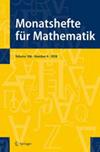关于有界系数单位的线性组合和双基数展开。
IF 0.8
4区 数学
Q2 MATHEMATICS
Monatshefte fur Mathematik
Pub Date : 2013-01-01
Epub Date: 2012-10-06
DOI:10.1007/s00605-012-0443-4
引用次数: 0
摘要
设[式:见正文]是一个数域的最大阶。贝尔彻在 20 世纪 70 年代证明,如果单位方程[公式:见正文]有一个非难解[公式:见正文],那么[公式:见正文]中的每一个代数整数都是一对不同单位的和。我们概括了这一结果,并给出了有符号的两位数展开式的应用。本文章由计算机程序翻译,如有差异,请以英文原文为准。
On linear combinations of units with bounded coefficients and double-base digit expansions.
Let [Formula: see text] be the maximal order of a number field. Belcher showed in the 1970s that every algebraic integer in [Formula: see text] is the sum of pairwise distinct units, if the unit equation [Formula: see text] has a non-trivial solution [Formula: see text]. We generalize this result and give applications to signed double-base digit expansions.
求助全文
通过发布文献求助,成功后即可免费获取论文全文。
去求助
来源期刊
CiteScore
1.60
自引率
11.10%
发文量
155
审稿时长
4-8 weeks
期刊介绍:
The journal was founded in 1890 by G. v. Escherich and E. Weyr as "Monatshefte für Mathematik und Physik" and appeared with this title until 1944. Continued from 1948 on as "Monatshefte für Mathematik", its managing editors were L. Gegenbauer, F. Mertens, W. Wirtinger, H. Hahn, Ph. Furtwängler, J. Radon, K. Mayrhofer, N. Hofreiter, H. Reiter, K. Sigmund, J. Cigler.
The journal is devoted to research in mathematics in its broadest sense. Over the years, it has attracted a remarkable cast of authors, ranging from G. Peano, and A. Tauber to P. Erdös and B. L. van der Waerden. The volumes of the Monatshefte contain historical achievements in analysis (L. Bieberbach, H. Hahn, E. Helly, R. Nevanlinna, J. Radon, F. Riesz, W. Wirtinger), topology (K. Menger, K. Kuratowski, L. Vietoris, K. Reidemeister), and number theory (F. Mertens, Ph. Furtwängler, E. Hlawka, E. Landau). It also published landmark contributions by physicists such as M. Planck and W. Heisenberg and by philosophers such as R. Carnap and F. Waismann. In particular, the journal played a seminal role in analyzing the foundations of mathematics (L. E. J. Brouwer, A. Tarski and K. Gödel).
The journal publishes research papers of general interest in all areas of mathematics. Surveys of significant developments in the fields of pure and applied mathematics and mathematical physics may be occasionally included.

 求助内容:
求助内容: 应助结果提醒方式:
应助结果提醒方式:


